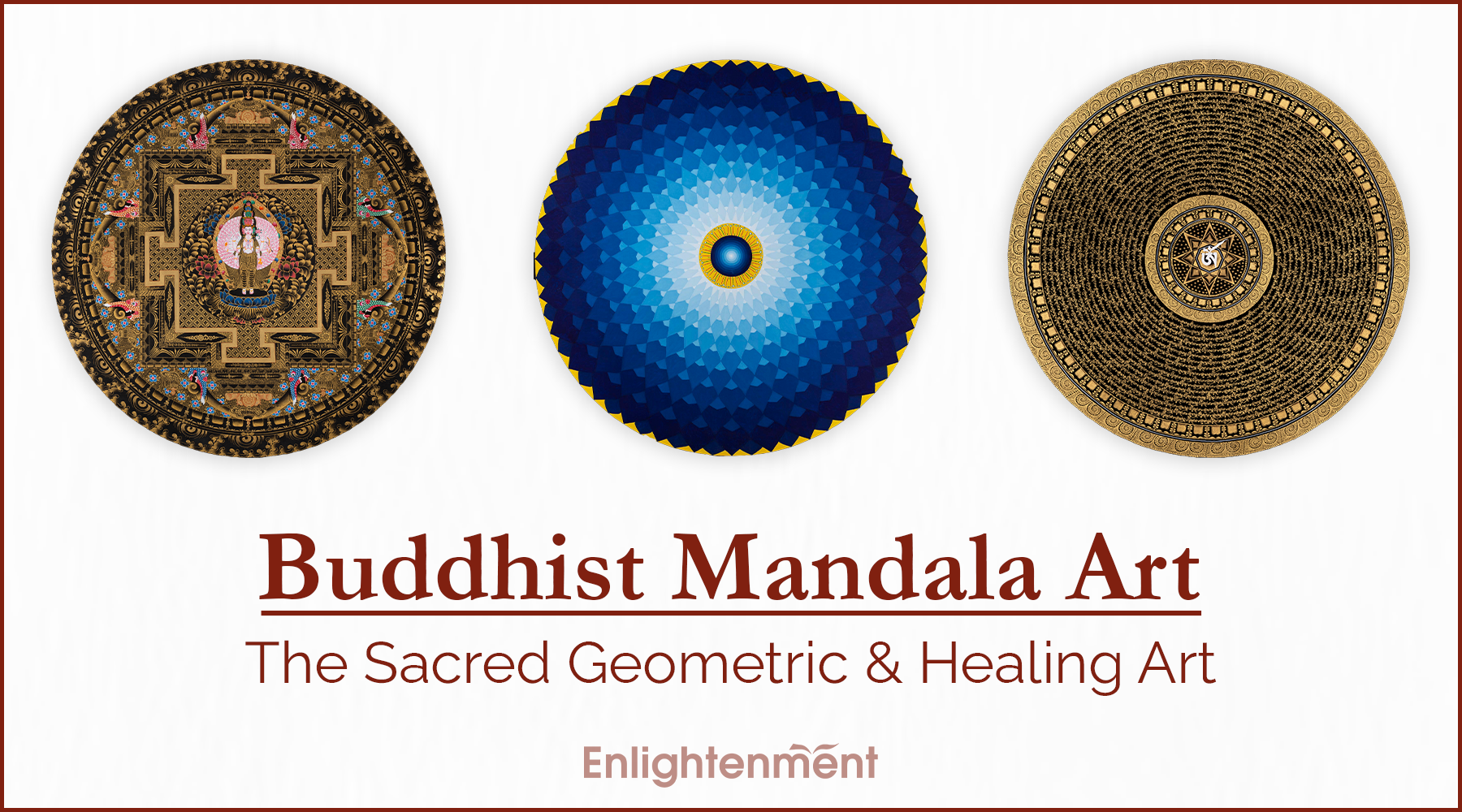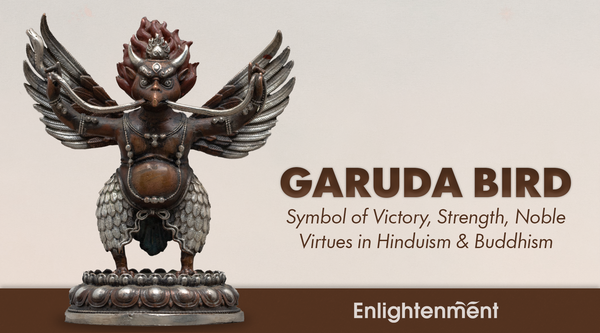Buddhist Mandala Art: The Sacred Geometric & Healing Art
Buddhism, an ancient spiritual tradition, has embraced art as a form of meditation and expression. Among its artistic wonders, Mandalas holds a profound place of reverence. These captivating and symmetrical designs have mesmerized people for centuries, inspiring a sense of awe and spiritual connection. These intricate and mesmerizing circular designs go beyond their aesthetic appeal, offering a gateway to more profound spiritual experiences.
Mandalas: Spiritual Gateways
Click here to view our Mandala Collection
At its essence, a Mandala represents a sacred geometric figure, typically in a circular form. "Mandala" originates in ancient Sanskrit, meaning "circle." Mandalas are sacred creations in Buddhist traditions, rich in symbolism and meticulously crafted.
A mandala is a geometric, circular work of art that has noteworthy spiritual and symbolic meaning, notably in Buddhism and Hinduism. It symbolizes a holy location frequently utilized for reflection, meditation, and visual assistance in religious rituals. They might have two dimensions, like in paintings and drawings, or three, like sculptures and buildings. A way to communicate with the divine and one's inner self, mandalas are thought to mirror the unity of the cosmos.
However, its essence expands far beyond a mere geometric shape. It symbolizes wholeness, unity, and the interconnectedness of all things, reflecting the cosmic order and the eternal cycle of life. When practitioners craft or gaze at Mandalas, they meditate enter a specific state of mind, transcending the material world and connecting with the divine.
The Origin & Evolution Of Mandalas
Mandalas have a history dating back thousands of years, with origins spanning various cultures and religions. The roots of Mandalas can be traced back to multiple cultures, including Indian, Tibetan, and Nepalese, with each tradition infusing its unique spiritual essence.
Mandalas emerged as a prominent art form in Buddhism around the 4th century. The intricate patterns and designs were skillfully integrated into religious rituals, meditation practices, monasteries and temple architecture, becoming an essential part of Buddhist culture.
Types Of Mandalas
Mandalas come in various forms, each serving a unique purpose:
-
Cosmic Mandalas
The cosmic mandala symbolizes the vastness and interconnectedness of the cosmos and the universe. It frequently integrates celestial components, cosmic symbols, and complex geometric patterns to represent the macrocosmic order and the interaction of heavenly forces. Using cosmic mandalas fosters a sense of harmony and unity with the cosmos by encouraging reflection on the magnificence of the cosmos and the connectivity of all things. -
Deity Mandala

A sort of mandala known as the "Deity Mandala," often referred to as the "Yidam Mandala" or the "Meditational Deity Mandala," depicts a particular deity or a collection of deities. Practitioners of Vajrayana Buddhism practice deity yoga, in which they imagine themselves to be the deity represented in the mandala. This practice aims to cultivate the enlightened attributes of the deity inside oneself, realize one's innate Buddha nature, and connect with those qualities. Deity mandalas frequently have the deity's main image encircled by various symbolic objects, such as lotus petals, shielding rings, and occasionally other attendant deities. -
Healing Mandala
A mandala created to encourage mental, emotional, or spiritual healing is called a healing mandala. These mandalas frequently include calming hues, wavy designs, and symbols of healing forces. It is said that making or meditating on healing mandalas has therapeutic advantages, assisting people in lowering stress and anxiety levels and enhancing general well-being. The act of working with a healing mandala is seen as a type of meditation that promotes inner healing.
-
Sand Mandala
Sand mandalas are made in a sacred method by Buddhist monks. A circle of delicate, multicolored sand is first formed to make a sand mandala, and then the sand grains are arranged in concentric circles. Following the established pattern, move inward while moving outward towards the center. Metal funnels are typically employed to ensure that a consistent volume is delivered at a time. -
Kalachakra Mandala

The Kalachakra Mandala is a complex and intricate sacred diagram used in Vajrayana Buddhism. "Kalachakra" translates to "Wheel of Time" in Sanskrit, and this mandala represents the cycle of time and the universe according to Buddhist cosmology. It is a symbolic representation of the Kalachakra Tantra, a significant text in Tibetan Buddhism. The mandala consists of various circles, squares, other geometric shapes, and specific deities and symbols with profound philosophical and spiritual meanings. - Mantra Mandala

-
Teaching Mandala
A teaching mandala is a visual tool in educational contexts, especially in some Buddhist traditions. It's a technique for making difficult lessons, philosophical ideas, or spiritual principles more understandable and remembered. Teaching mandalas may contain signs, pictures, and diagrams that reflect different facets of the lessons and aid students in understanding and remembering the information being prepared. -
Contemplative Mandala
A mandala that promotes intense reflection and contemplation is known as a Contemplative Mandala. The rich and detailed designs of these mandalas encourage a state of focused meditation and self-awareness, which typically attract the viewer's attention inward. Contemplative Mandalas examine inner thoughts and feelings, relax the mind, and discover new perspectives.
The Intricate Symbolism Of Mandala
Every element within a Mandala holds profound symbolism. The central point, known as the "Bindu," signifies the starting point of creation and the eternal energy source. The outer circle represents the cycle of life, death, and rebirth, while intricate patterns and colors convey specific aspects of the spiritual journey. Mandalas reflect the impermanence of existence and the eternal search for enlightenment.
-
Cosmic Unity
At the heart of every Mandala lies the concept of cosmic unity. The circular shape represents the universe and its boundless nature. Mandalas remind us that we are inseparable from a greater whole, interconnected with all living beings and the cosmos. -
Spiritual Journey
Embarking on a spiritual journey is a central theme in Buddhism, and Mandalas serve as powerful guides along this path. Their intricate patterns and repetitive designs mirror the complex layers of the self, guiding individuals toward self-discovery, enlightenment, and inner peace.. -
Balance and Harmony
Mandalas are meticulously balanced and harmonized compositions. As one gazes upon a Mandala, a sense of tranquility and balance washes over, calming the mind and nurturing meditative awareness.
Mandalas In Buddhist Art
-
Thangka Paintings
Thangka paintings, exquisite religious artworks on fabric, prominently feature Mandalas. These paintings serve as visual aids for meditation, depicting deities and sacred symbols within a Mandala's structure, inviting practitioners to contemplate and connect with the divine. -
Monasteries, Temple and Shrine Decor
Buddhist temples and shrines are adorned with Mandalas, transforming the spaces into ethereal realms of spiritual significance. The presence of Mandalas enhances the sacred atmosphere, inspiring devotees in their devotional practices.
Mandalas As Meduim For Meditation
In Buddhist meditation, Mandalas are potent aids to focus the mind and achieve mental clarity. By visually and mentally absorbing the harmonious patterns, practitioners can transcend the complexities of life, attaining a sense of peace and balance. Creating Mandalas artcrafts also fosters mindfulness and self-awareness, leading to a deeper understanding of oneself and the interconnectedness with the universe.
Mandalas serve as gateways to altered states of consciousness. It can facilitate moments of transcendence as one dives deeper into meditation, leading to profound insights and spiritual revelations.
-
Focus and Concentration
Meditating on a Mandala can be a transformative experience. The intricate details and patterns draw the practitioners/meditator's focus, helping them achieve a state of heightened concentration and allowing thoughts to fade away, paving the way for profound inner stillness. -
Transcendence and Insight
Mandalas serve as gateways to altered states of consciousness. It can facilitate moments of transcendence as one dives deeper into meditation, leading to profound insights and spiritual revelations.
Mandalas and the Pursuit of Enlightenment
Central aspect to Buddhism is pursuing enlightenment, the ultimate state of awakening and liberation from suffering. Mandalas play a pivotal role in this pursuit, as they aid in transcending the mundane world and accessing deeper realms of consciousness. Meditating on it facilitates the inner journey, leading practitioners towards enlightenment and profound wisdom.
Colors used in Mandala and their meaning
In Mandalas, the colors used can hold various symbolic meanings and interpretations depending on cultural, religious, and personal contexts. Here are some common implications associated with colors:
- Red: Represents energy, passion, strength, and life force. It can also symbolize love, courage, and intense emotions.
- Blue: This signifies calmness, tranquility, and spiritual qualities. It can also represent the sky, infinity, and expansiveness.
- Yellow: Symbolizes brightness, optimism, joy, and intellect. It is associated with the sun, light, and enlightenment.
- Green: Represents nature, growth, harmony, and renewal. It can also represent balance and healing.
- Orange: Signifies creativity, enthusiasm, and vitality. It is often associated with transformation and spiritual awakening.
- Purple: Represents spirituality, intuition, and higher consciousness. It is linked to mystery, magic, and the cosmos.
- White: Symbolizes purity, clarity, and transcendence. It is often associated with spiritual enlightenment and the divine.
- Black: Represents the unknown, the unconscious, and the depths of the mind. It can also symbolize mystery and potential.
- Pink: Signifies love, compassion, and tenderness. It is often associated with the heart and emotional healing.
- Brown: Symbolizes stability, grounding, and the earth. It can represent a connection to the natural world.
The interpretations of colors in Mandalas can vary across different cultures, belief systems, and individual preferences. The use of specific colors in a mandala often depends on the intentions of the creator or the intended purpose of the Mandala itself.
Significance of Crafting Mandalas
-
Therapeutic Benefits
Creating Mandalas can be a therapeutic and healing process. The act of crafting intricate designs fosters mindfulness and a sense of calm. It becomes an avenue for emotional expression and a way to cope with life's complexities.
-
Self-Expression
Each individual's Mandala reflects their inner world and unique journey. Engaging in the creative process of making Mandalas allows for a deeply personal and introspective experience.
The significance of Mandala in Buddhist art and meditation is profound and timeless. These mesmerizing geometric designs serve as gateways to spiritual realms, aiding practitioners in pursuing enlightenment and mindfulness. As the world embraces the healing power of art, Mandalas continue to inspire, empower, and connect individuals with the essence of their being and the vast universe.


